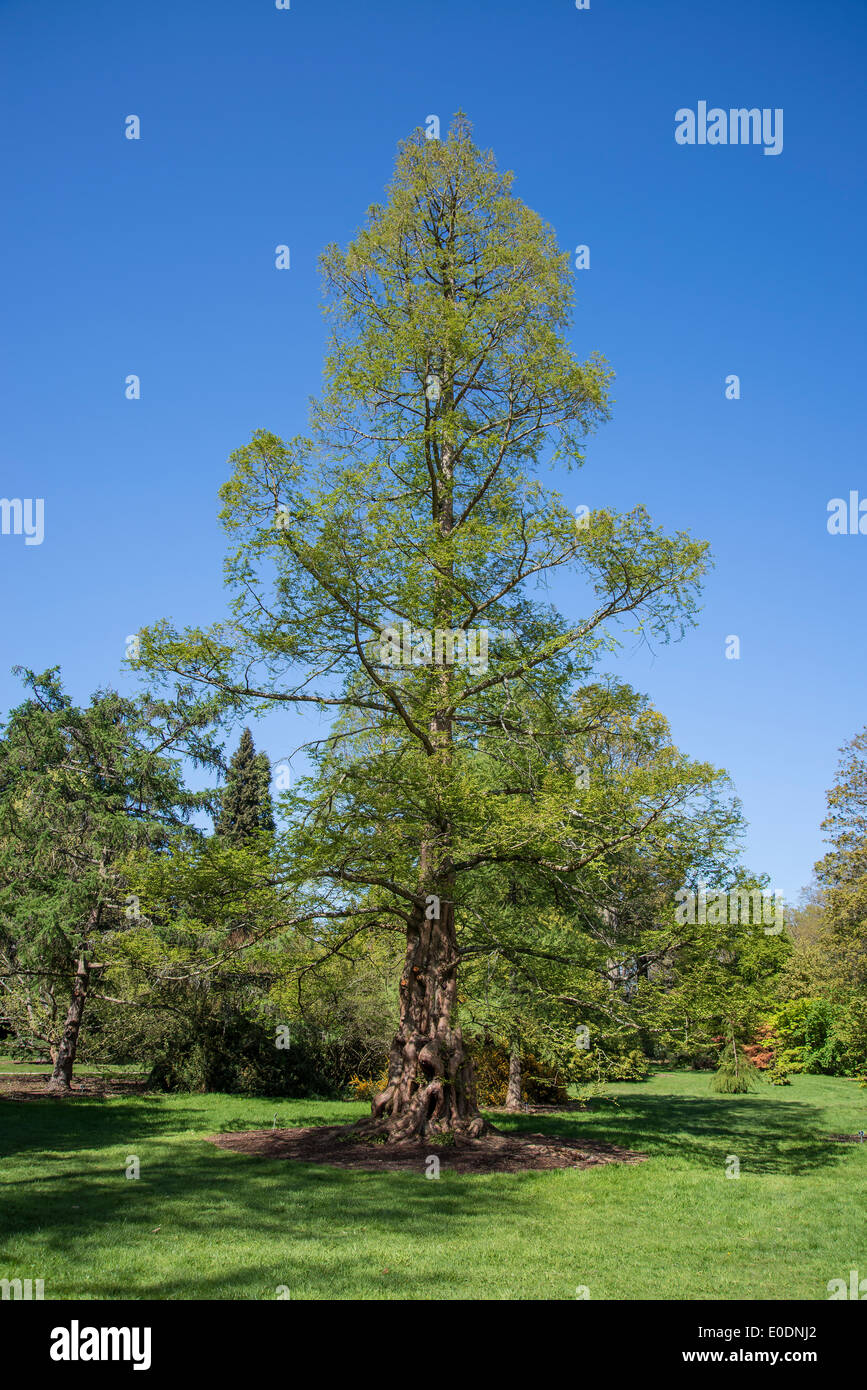New genus Metasequoia was proposed to accommodate these; and only four years after that genus described, a living species was actually found in China. This, because of the ancient lineage of Metasequoia, and its former wide geographic distribution (various parts of North America, Japan, Saghalien, Manchuria), is a most extraordinary circum-stance. Although native to China, reliable Metasequoia megafossil records from only nine localities ranging from the Late Cretaceous to the middle Miocene have been reported in this country to date, most of them were reported from the northern part of China. Somewhere in the Sauraton Mountains of North Carolina, lies the Crescent Ridge Dawn Redwoods Preserve; a private endeavor to re-establish a self regulating forest of metasequoia in the Appalachian region.Here, among 50 acres of misty hills and hollows, dawn redwoods flourish in an environment strikingly similar to the Sichuan and Hubei provinces of China. On the unsolved mystery of Metasequoia - Chinese with English Summary 2003, and Japanese with English Summary 2003. The Chronology of The 'Living Fossil' Metasequoia glyptostroboides (Taxodiaceae) - A Review (1943-2003) - Chinese, Deutsch, English, Espanol, Japanese.
Somewhere in the Sauraton Mountains of North Carolina, lies the Crescent Ridge Dawn Redwoods Preserve; a private endeavor to re-establish a self regulating forest of metasequoia in the Appalachian region. Here, among 50 acres of misty hills and hollows, dawn redwoods flourish in an environment strikingly similar to the Sichuan and Hubei provinces of China. Located some five to six hundred miles further to the north, but at a lower altitude, CRDRP provides a virtually identical, although slightly cooler, climate to the Chinese forests in the Shui-sa Valley that Metasequoia has called home for the past several million years. In China, dawn redwoods grow amidst oak, sweetgum, sassafras, hemlock, chestnut, and Katsura trees. | |||||
| |||||
| |||||
The preserve is tentatively scheduled to open to the public in 2035. Visitors will be able to wander pathways through groves of dawn redwoods. The project's goal is 5000+ metasequoias, plus the other large species mentioned earlier. “I have laid the preserve out like the national parks out west,” Doug says, “Just on a smaller scale. We will simulate old growth characteristics, such as a planted ‘fairy ring’, to serve as a natural pulpit for wedding ceremonies. People will walk on pathways created before the trees were planted, giving the effect of ancient Indian trails. The trails will open into pure groves of dawn redwoods with mixed forest in between. We would also like to design one or two hilltop overlooks with views of the surrounding mountains, and possibly even a cabled suspension bridge across one of the hollows to bring visitors through the treetops of dawn redwoods.” | |||||
| CRDRP will also offer a Visitor's Center, with films and interpretive exhibits, including many fossils of Metasequoia, silicified cones, petrified wood, and samples of dawn redwood, including a section of log. It will also feature anything “metasequoia related”, such as stamps, articles, photographs, etc. A preview of this can be seen here on the site, in the “Cool Stuff” area. As the project progresses, more information will become available, and hopefully added to the site for reference. | |||||
The location of the preserve must remain vague, at least for now, for obvious reasons. If people knew there were redwoods in the vicinity, they might search for giant trees, possibly trampling seedlings in their quest. Vandalism would also be likely to occur. So for now, the exact location of the Crescent Ridge Dawn Redwoods Preserve must remain a secret, except to a few individuals in related fields. People who are genuinely interested in the project may contact Special Ranger Doug Hanks for further information. We at the Crescent Ridge Dawn Redwoods Preserve hope you have | |||||
Doug Hanks © 2005 | |||||
By J. Zimmerman, Ph.D.
| Coast Redwood: A Natural and Cultural History by Michael G. Barbour (Editor), et al. Refers to dawn redwoods as well as coast redwoods. | Book Review of Discovered Alive: The Story of the Chinese Redwood by William Gittlen (Pierside Publications). |
| Deforesting the Earth: From Prehistory to Global Crisis by Michael Williams. | |
| Books read. | |
| Ecology. Evolution notes. | A Guide to the Sequoia Groves of California by Dwight Willard - a well-illustrated introduction to the Sequoia groves of the Sierra Nevada. |
| Trees of North American. Trees of the American Pacific Northwest. | Forest and Tree Home, Glossary pages: A, B, C, D, E, F, G, H, I, J, K, L, M, N, O, P, Q, R, S, T, U, V, W, X, Y, Z. |
Why we care about the Dawn Redwood (Metasequoia glyptostroboides). |
Metasequoia is a fascinating international tree. Native only to China, it is grown as a guest tree world-wide and especially in California:
- Metasequoia appears in the fossil record in California.
- Many individuals and organizations (including the D.A.R. or Daughters of the American Revolution) have planted and nurtured Metasequoia in urban forests and arboretums throughout California.
- As a fossil, Metasequoia was recognized as a separate species from the coast redwood (Sequoia sempervirens) only in the mid-twentieth century, by a researcher in Japan.
- Independently, in 1941, a forester in China discovered the revered, living Metasequoia, in the village of Motaochi.
Recognizing Metasequoia glyptostroboides. |
There may be a Metasequoia in your neighborhood. Look for these features (and for more details see Discovered Alive: The Story of the Chinese Redwood by William Gittlen. Pierside Publications):
- Metasequoia glyptostroboides is a tall, symmetrical tree with a straight and slim truck, upswept branches. Typical height of the mature tree is 110 feet.
- Metasequoia does not sprout from the root, so the shape of a free-standing tree is clear.
- A deciduous conifer, its leaves turn gingery in autumn and then they fall off, revealing the astonishing straightness of the tall truck.
- Bark: Reddish. Finer and less rough than Sequoia sempervirens.
- Leaf: Needles, 1' long and slim, in a plane, and opposite. Leafy twigs are opposite on branches. Beautiful, almost etherial, pale-green spring foliage.
- Seed: Within cones 1' or slightly longer, almost as wide as long. Cone scales are opposite. Cones hang in groups at the ends of branches; as the cones grow heavier, they pull the branches down.

Where to see Metasequoia glyptostroboides. |

- In the wild. Metasequoia is found in very small, protected, and isolated areas China, in Sichuan (Szechuan) and Hubei (Hupeh) provinces.
- In the urban forest. Since its dramatic 'discovery' in the mid-twentieth century, the Metasequoia has been widely planted in towns throughout China, North America, and Japan.
- In New York City. Andy Young reports (The New Yorker (May 23, 2005 issue)), in his article 'Street Life: Tree Count' on the 2005 citywide census by a thousand volunteers of the half million NYC street trees, that he has seen dawn redwoods in the vacinity of Madison and Park Avenues:
'A few years ago, the owners of the co-op on the corner asked the Parks Department for 'something special,' then paid for these trees and steel tree guards... 'Imagine, if you will, a feathery, light-leafed dawn redwood, fifty feet tall, shading the building, dropping its whispery leaves,' he [Gunther] said quietly. 'I just think it's a wonderful thing. I like it.' - In California. You are more likely to find Metasequoia in the west of the state. Use the guidelines above for recognition. Or contact your local arboretum or Department of Parks and Recreation. They will be able to tell you where you can see the Metasequoia in your area.
Metasequoia China

How to Grow. |
See How to Grow a Dawn Redwood, where Scott Peden suggests an approach to growing your own Dawn Redwood tree from seeds.
For More Information. |
Resources - Book.
- Book Review ofDiscovered Alive: The Story of the Chinese Redwood by William Gittlen (Pierside Pubications). Sadly Amazon no longer stocks this interesting book. Request it from your local library. ISBN is 0966921747.
- Coast Redwood: A Natural and Cultural History by Michael G. Barbour (Editor), et al. Refers to dawn redwoods as well as coast redwoods.
Resources - Related pages.
- Home and Index of Articles.
- Dawn Redwood - Time Chart - longevity, history, pre-history.
- Dawn Redwood - How to Grow.
- Pine Trees - Your 60-Second Guide to Naming your Pine.
- Got Conifer -- How You Can Tell What Kind of Conifer You Have.
- The Families of Trees in the Sierra Nevada.
- The Pine Family of Trees in the Sierra Nevada.

| Glossary pages: A, B, C, D, E, F, G, H, I, J, K, L, M, N, O, P, Q, R, S, T, U, V, W, X, Y, Z. |
Metasequoia Trees China
| Copyright © 2001-2016 by J. Zimmerman. |

